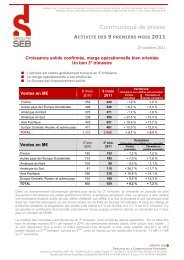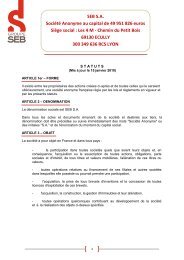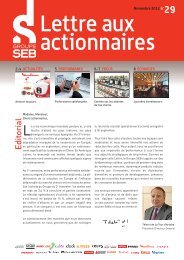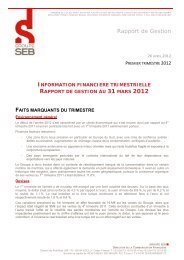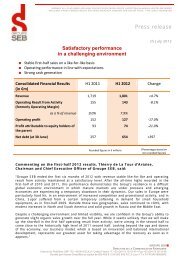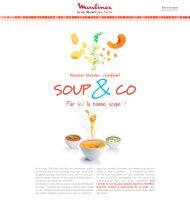financial report and registration document 2011 - Groupe SEB
financial report and registration document 2011 - Groupe SEB
financial report and registration document 2011 - Groupe SEB
You also want an ePaper? Increase the reach of your titles
YUMPU automatically turns print PDFs into web optimized ePapers that Google loves.
1.3. BUSINESS SECTORS<br />
As a global leader in small domestic equipment, <strong>Groupe</strong> <strong>SEB</strong> deploys its<br />
strategy via a portfolio of diversifi ed <strong>and</strong> complementary br<strong>and</strong>s in multiregion<br />
or local markets. <strong>Groupe</strong> <strong>SEB</strong> st<strong>and</strong>s out from its main rivals by being<br />
present in both the small domestic appliance sector (which accounts for<br />
70% of its sales) – estimated to be worth approximately €29 billion – <strong>and</strong><br />
cookware (a sector worth around €9.5 billion). These fi gures, which vary<br />
signifi cantly in relation to those published in 2010, correspond to a new<br />
defi nition of the world market in question, with greater coverage in terms of<br />
both geography <strong>and</strong> market segments. Therefore, they include more specifi c<br />
data on all emerging markets (such as India, South-East Asia, the Middle<br />
East, etc.) <strong>and</strong> incorporate, for instance, soya milk makers within product<br />
families. Soya milk machines were not previously included, but they represent<br />
an estimated market of €500 million worldwide.<br />
Overall, the small domestic equipment sector is characterised by:<br />
� low-to-moderate, yet steady, dem<strong>and</strong> in the majority of mature markets –<br />
where although the equipment rate is already high, it is heterogeneous in<br />
terms of product families. This dem<strong>and</strong> is, however, mixed <strong>and</strong> driven by<br />
strong reactivity to innovation (new products <strong>and</strong> concepts), by the need<br />
to upgrade the range in search of more status-related products, <strong>and</strong> by<br />
the desire for basic products at low prices; At the same time, dem<strong>and</strong> is<br />
sharply on the rise in emerging markets (double digit growth in Asia <strong>and</strong><br />
almost-double digit growth in Latin America). These markets are in an<br />
equipment phase <strong>and</strong> their intense growth is fuelled by rapid urbanisation<br />
<strong>and</strong> the development of the real estate market, booming middle class<br />
access to consumption, development of modern retail distribution, etc.;<br />
� an average sale price close to €55 for a small domestic appliance in<br />
developed countries, being accessible for most consumers <strong>and</strong> requiring<br />
no or very limited use of credit;<br />
� shorter product use cycles in addition to an increasing average equipment<br />
rate in certain categories which are driving these renewal markets;<br />
� steady <strong>and</strong> increasingly unavoidable increase in industrial partnerships<br />
between manufacturers of small domestic appliances <strong>and</strong> actors of various<br />
mass consumer goods, especially through joining forces to propose new<br />
offerings <strong>and</strong> services. Development of the single-portion coffee concept<br />
is a signifi cant example;<br />
� tighter market fundamentals, as mass retailing increasingly imposes a<br />
low price policy <strong>and</strong> continues to exert pressure on supply, pushing many<br />
products toward the entry-level end of the spectrum. This results in little<br />
or no innovation <strong>and</strong> a race to exp<strong>and</strong> among manufacturers/suppliers.<br />
While such trends have been the norm in the USA <strong>and</strong> the UK for many<br />
years, this phenomenon is beginning to spread into other markets;<br />
� the emergence of new consumer trends worldwide: more “Western” in<br />
Asian or South American countries, more “ethnic” in Western countries,<br />
back to “home-made” <strong>and</strong> control over food in Europe, heightened<br />
environmental awareness, etc.;<br />
Financial Report <strong>and</strong> Registration Document <strong>2011</strong><br />
1<br />
Presentation of the Group<br />
Business sectors<br />
Breakdown of the small domestic equipment market, by<br />
product family<br />
Cookware 24%<br />
Food preparation 10%<br />
Beverage preparation 10%<br />
Electrical cooking 11%<br />
Sources Estin & Co- <strong>Groupe</strong> <strong>SEB</strong><br />
7% Linen care<br />
10% Personal care products<br />
10% Home comfort<br />
18% Home care<br />
From a geographical viewpoint, the global market of Small Domestic<br />
Equipment does not present any real homogeneity because it is fragmented<br />
into numerous national/regional markets. These are fuelled by a complex<br />
<strong>and</strong> multi-faceted retail distribution network that varies depending on<br />
regional consumption habits, the maturity of markets, targets or product<br />
ranges <strong>and</strong> the development of distribution systems: (hyper/supermarkets,<br />
specialist retailers, department stores, traditional points of sale, high-end<br />
boutiques, etc.), as well as the rapid development of alternative distribution<br />
channels (the Internet, factory shops, own-br<strong>and</strong> stores, discounters, etc.)<br />
in recent years. Online sales have experienced particularly rapid growth.<br />
For more than a decade now, a growing part of the production of small<br />
domestic appliances has been located in countries with low production costs,<br />
especially in China, due to the availability of low-cost labour. For certain<br />
products, stemming mostly from assembly processes (toasters, coffee fi lters,<br />
kettles, hair dryers, etc.), nearly all global manufacturing is based in China. In<br />
fact, the small size of these products makes it easy for them to be shipped<br />
over long distances at very reasonable costs <strong>and</strong> therefore to be competitive<br />
in their destination markets. This phenomenon is more evident on entry level<br />
or low value-added products.<br />
In recent years most markets have seen greater pressure to offer price<br />
reductions <strong>and</strong> promotions, with a signifi cant rise in discount products, which<br />
are more <strong>and</strong> more often sold under retailer br<strong>and</strong> names.<br />
GROUPE <strong>SEB</strong><br />
1<br />
7



